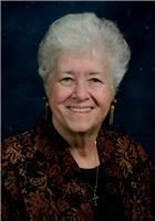 Madelyn Eastlund Madelyn Eastlund This blog-post is dedicated to a great poet that I'm almost sure you've never heard of but definitely need to know. So, I want to introduce you to her work. But before I do, I'd like to sing out some personal praises for Madelyn Eastlund because she was one of my most important poetic mentors. Mentors are a big part of any artist's journey. I've had many. Some good; some not so good. Madelyn Eastlund is high on my "good mentors" list and there are many reasons for that. The first reason is that, early on in my writing career after publishing a handful of my poems in her Harp Strings Poetry Journal, she invited me to participate in Poet's Forum Magazine. PFM was a print magazine where poets published poems and commented on each others poems. This was an incredible experience and I learned to shop-talk and swap criticism with some of the most talented and ambitious poets around. From PFM I took away two indispensable lessons for any poet: 1) You're never as good as you think you are. 2) There's always somebody better. But, believe it or not, these are good things. Trust me, learning to face robust criticism from your peers (and potential audiences) and learning from that criticism will double your creative power. The second reason that Madelyn is one of my top mentors is because of her native talent and skill. She wrote dozens of exceptional poems and had a clear and consistent knack for setting, image, and theme. Yes, I did learn a few things from Madelyn Eastlund about how to stay prolific, as well as how to access and refine my own skills and I'll happily share a bit now and more in future blogs. But now let's turn to one of Madelyn's many excellent portrait-poems. The poem: "Grandma's Eighty-Fifth Birthday," is from a slim chapbook of Madelyn's titled Portraits. There's not a bad poem in the book, but I think this one's my favorite. The poem is a single stanza, twenty-two lines in irregular meter. When I say "irregular" I mean irregular. Some lines have a single syllable; others stretch out to five or more. Madelyn was an ace with poetic forms. If you click her picture above, it will take you to a page with three of her poems: a Malayan Pantoum, a Roundeau Redoublé, and a prose poem, all executed with precision and panache. So her choice to present this poem in a single stanza with irregular meter is no accident. It is , in fact, a way to represent the rush of time and fragmentation of life that is universally understood as part of aging. The poem starts with the lines: Her voice is a brook babbling on; her hands are the wings of a butterfly fluttering in the air. Note the alliteration between "babbling" and "butterfly." This is important because, taken together, the words make "babbling butterfly" which is exactly what Madelyn wants us to see in her portrait of Grandma. Butterflies are symbols of the soul and of transformation. This gives the stanza a hopeful lilt as it careens on through a depiction of old-age: She gives the street a quizzical look But goes on to cross the street "as quick as a deer" which, for those of you who are familiar with hermetic symbolism, is another symbol of transformation. The old woman has become a "babbling butterfly" and then a deer. Finally, in the final eight lines, her memory is described as bird that flies from the nest and comes back sometimes to sing: of almost remembered things slightly awry. The next transformation is not spelled out, but we can guess what it might be. Since the word "things" is given so much emphasis and it's connected to the word "awry," the obvious conclusion is that the old woman is becoming less concerned with the world of things. "Awry" forms an unexpected rhyme with "butterfly" and lets us know that the "butterfly/deer/bird" part of the woman is starting to lose contact with earthly things. She's becoming pure soul. This is what good poets do. And Madelyn Eastlund was one of the greats. I encourage you to check out her work wherever and whenever you can find it. Meanwhile, if you'd like to discuss mentors, poems, souls, or anything else just hit the talk button up top or down below. I'll blog more on Madelyn and my other poetic mentors from time to time. It's an important topic. One fun form I learned from Madelyn that she was particularly strong with was the haibun. Click the buttons below to see on old example of one of mine and a web article on how to write one yourself. Categories All
0 Comments
|
